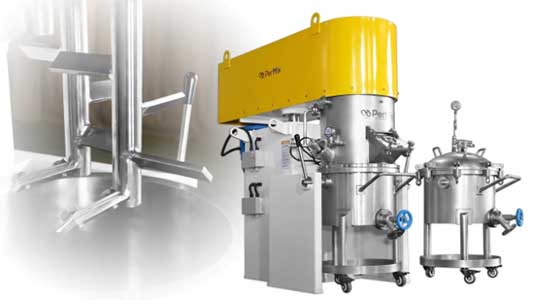In the heart of factories worldwide, industrial mixers are the unsung heroes ensuring consistency, quality, and efficiency across countless industries—from food and beverages to pharmaceuticals, chemicals, and construction materials. Yet while mixers have been a mainstay of manufacturing for decades, they are now undergoing a remarkable transformation driven by Industry 4.0 technologies.
By 2032, the size of the global industrial mixers market is expected to have grown from US$ 2,839.4 million in 2025 to US$ 4,297.7 million. A compound annual growth rate (CAGR) of 6.1% is projected for the 2025–2032 prediction period.
The convergence of sensors, data analytics, machine learning, and connected systems is fundamentally reshaping how industrial mixers operate, are maintained, and deliver value. As manufacturers face rising pressure for efficiency, sustainability, and product traceability, the humble industrial mixer is becoming a strategic asset in the smart factory ecosystem.
This article explores how Industry 4.0 is redefining the industrial mixing landscape, the latest trends shaping adoption, and how forward-looking businesses are leveraging these innovations to gain a competitive edge.
A Shift From Mechanical Workhorses to Smart Assets
Traditionally, industrial mixers were designed with a singular focus: mechanically blending raw materials to meet specific process requirements. Performance was measured primarily by metrics like mixing time, energy consumption, and batch consistency. However, visibility into what happened inside the mixer was limited, often relying on operator experience, periodic sampling, and manual testing.
Industry 4.0 has dramatically shifted this paradigm. Smart mixers now feature a dense network of sensors measuring variables such as:
- Torque and viscosity
- Temperature distribution
- Particle size reduction
- Motor load and energy usage
- Vibration and mechanical health indicators
- Mixing homogeneity in real-time
These insights enable unprecedented visibility and control over mixing processes. Manufacturers can now monitor, analyze, and optimize mixing operations with precision that was impossible a decade ago.
Predictive Maintenance Reduces Downtime
One of the most significant impacts of Industry 4.0 on industrial mixers is predictive maintenance. Instead of relying on time-based servicing schedules or waiting for failures to occur, smart mixers use sensor data to identify subtle performance anomalies that might signal emerging mechanical problems.
Machine learning algorithms can analyze vibration signatures, torque fluctuations, and other data streams to detect early signs of issues such as:
- Bearing wear
- Shaft misalignment
- Gearbox failures
- Imbalanced loads
By predicting failures before they cause unplanned downtime, manufacturers save significant costs and avoid production disruptions. According to McKinsey, predictive maintenance can reduce machine downtime by 30-50% and lower maintenance costs by 20-30%.
For industries with stringent quality standards—such as pharmaceuticals or food processing—this reliability is invaluable. A sudden mixer failure could compromise product integrity, trigger recalls, or cause costly production losses. Smart maintenance keeps production running smoothly while protecting brand reputation.
Advanced Process Optimization Through Data Analytics
Beyond maintenance, Industry 4.0 is revolutionizing how manufacturers optimize mixing processes. According to insights from Persistence Market Research, data-driven technologies are transforming mixers from rigid machines into adaptive systems that adjust in real time for maximum efficiency and quality.
Consider the production of high-viscosity adhesives. Even small variations in temperature, mixing speed, or ingredient ratios can significantly impact product properties such as strength, cure time, and shelf life. Traditionally, achieving optimal outcomes required extensive trial and error.
Today, mixers integrated with advanced analytics and digital twins can simulate process conditions and recommend precise adjustments. By analyzing past batches and real-time process data, these systems identify optimal operating parameters and predict final product quality.
A notable example is the use of Artificial Intelligence (AI) in pharmaceutical mixing. Machine learning models trained on historical data can predict the optimal mixing time to achieve uniform drug dispersion, reducing batch failures and ensuring regulatory compliance.
For manufacturers, this translates into:
- Shorter product development cycles
- Higher product consistency
- Reduced raw material waste
- Lower energy costs
As sustainability gains importance, minimizing waste and energy consumption isn’t just an operational advantage—it’s becoming a business imperative.
Batch Traceability and Compliance
Another major driver for adopting smart mixers is the increasing emphasis on traceability and regulatory compliance. Industries such as food processing, pharmaceuticals, and specialty chemicals face rigorous demands to document every step of their production process.
Modern mixers equipped with IoT connectivity automatically log key process data, including:
- Start and end times
- Ingredient weights and sequence
- Motor load profiles
- Temperature and viscosity readings
- Operator interventions
This digital record-keeping ensures complete traceability of every batch produced. In case of a product recall or quality audit, manufacturers can quickly pinpoint the root cause and isolate affected batches.
Beyond compliance, these digital records support process improvement efforts by allowing engineers to analyze production trends and identify opportunities for optimization.
Integration With Broader Industry 4.0 Ecosystems
The true power of Industry 4.0 emerges when smart mixers connect seamlessly with broader factory systems, including:
- Manufacturing Execution Systems (MES)
- Enterprise Resource Planning (ERP)
- Warehouse Management Systems (WMS)
- Quality Management Systems (QMS)
For example, real-time mixer performance data can feed into MES platforms, enabling automated scheduling adjustments if a mixing process finishes faster than expected. Integration with ERP systems ensures accurate material planning and inventory management.
Similarly, cloud-based platforms allow manufacturers to aggregate mixer data from multiple production sites, facilitating enterprise-wide analytics and benchmarking. This level of integration is essential for global manufacturers seeking to standardize quality and operational excellence across diverse locations.
Emerging Trends in Industrial Mixing
Several trends are shaping the next chapter of Industry 4.0 in the industrial mixer market:
1. Edge Computing
While cloud solutions remain critical for big data analysis, edge computing is gaining traction in mixer applications. By processing data locally at the mixer, edge devices enable rapid response times and reduce network dependency. For real-time control applications—such as maintaining precise mixing temperatures—edge computing ensures lower latency and greater resilience.
2. Modular Mixer Designs
Manufacturers are increasingly adopting modular mixer systems that can be configured and reconfigured quickly to produce different products. Industry 4.0 tools make it easier to switch recipes, adjust process parameters, and validate new configurations, shortening changeover times and boosting manufacturing agility.
3. Sustainability-Focused Mixing
Energy optimization is a major priority. Smart mixers can dynamically adjust speed and torque to minimize power consumption without sacrificing product quality. Additionally, data analytics help manufacturers identify ways to reduce raw material waste, aligning production with sustainability goals.
4. Digital Twins
Digital twin technology is gaining momentum in mixer applications. A digital twin creates a virtual replica of a physical mixer, allowing engineers to simulate process changes and predict outcomes without disrupting live production. This accelerates R&D and supports rapid scale-up of new formulations.
The Business Case for Investment
As global competition intensifies and customer expectations evolve, investing in Industry 4.0-enabled mixing technology is no longer optional for manufacturers seeking to stay ahead. While upfront costs can be significant, the return on investment is compelling:
- Improved product quality and consistency
- Reduced downtime and maintenance costs
- Faster time-to-market for new products
- Enhanced traceability and compliance
- Lower energy and raw material consumption
Market analysts project strong growth for smart mixing equipment in the years ahead. According to a recent MarketsandMarkets report, the global industrial mixing equipment market is expected to exceed USD 11 billion by 2028, driven in part by rising Industry 4.0 adoption.
Conclusion: Mixing Smarter for the Future
The industrial mixer, once viewed merely as a mechanical machine, is becoming a cornerstone of the smart factory. Industry 4.0 technologies are unleashing a new era of precision, efficiency, and sustainability in mixing processes, transforming how manufacturers design, operate, and maintain their equipment.
Companies that embrace this evolution stand to gain not just operational benefits, but a strategic advantage in a world demanding faster innovation, higher quality, and greater environmental stewardship.












